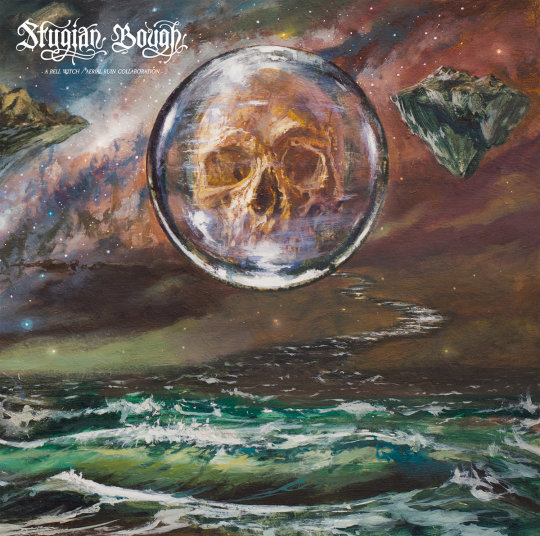#Jesse Shreibman
Text
Bell Witch - Mirror Reaper (October 20th, 2017)
Lineup:
Dylan Desmond - Vocals, Bass
Jesse Shreibman - Vocals, Drums, Organ
Guest/Session:
Adrian Guerra (R.I.P. 2016) - Vocals
Erik Moggridge - Additional Vocals
#Bell Witch#Funeral Doom Metal#Doom Metal#Dylan Desmond#Jesse Shreibman#Adrian Guerra#Erik Moggridge#United States#USA#US#Profound Lore Records#Canada#Bandcamp
32 notes
·
View notes
Text

BUZZ_BINNED:

“AUTOBAHN” is the lead single from @alexeishishkin_’s forthcoming LP titled ‘Open Door Policy’ (5/28 @candlepin_records) & it finds the Queens-based artist, rounded out here by Graham W. Bell (guitar/vox), Bradford Krieger (production/guitar/vox/drums), Dave Kahn (bass), Ian Dwy (drums), Bill Waters (guitar/keys) & Ivan Rodriguez (sax) bringing the whimsy across a 2:40 clip of indie driven SlackerPop.

“YUCKY” is the lead track from CHAARM’s recently released self-titled demo collection & it finds the Los Angeles-based artist (& homie of the blog) @careezy bringing 3+ mins of EMOtionally gazed, crunchily crisp & generally what_have_you’d AltRawk… get it my boy!!!

“RIPENED PSYCHOSIS” (@20buckspinlabel) is the lead track on @corpusoffalofficial’s recently released demo & it finds the veteran crew of Cerebral Rot’s lead guitarist/vocalist Ian Schwab & guitarist Clyle Lindstrom linking up w/ Jesse Shreibman (Bell Witch, Autophagy) on drums and Jason Sachs (ex-Demoncy) on bass to bring a sprawling 7 mins of ghastly doomed & deathly blackened Metal.
#music#screamingforyears#songs#metal#doom#deathmetal#blackmetal#postpunk#indie#rock#indierock#goth#aesthetic#alternative#Bandcamp#Spotify
0 notes
Text
BELL WITCH Presents 'Mirror Reaper' In Visual Album Format; EU Tour Dates
BELL WITCH Presents ‘Mirror Reaper’ In Visual Album Format; EU Tour Dates
Article By: Pat ‘Riot’ Whitaker, Senior Writer/Journalist ‡ Edited By: Leanne Ridgeway, Owner/Chief Editor
In October 2017, Seattle’s dark duo of funeral doom, BELL WITCH, issued their third album ‘Mirror Reaper‘ via Profound Lore Records. (more…)
View On WordPress
#2017#Bell Witch#Branca Studio#Doom#Drone#Dylan Desmond#Europe#Festival#Funeral Doom#Into Darkness Festival#Jesse Shreibman#Mirror Reaper#Official Video#Profound Lore Records#Taylor Bednarz#Tour
1 note
·
View note
Audio
Bell Witch
Album/Song: Mirror Reaper
Genre: Doom Metal
Year: 2017
1 note
·
View note
Audio
Mirror Reaper by Bell Witch
#somethingneweveryday#music#metal#doom metal#funeral doom metal#bell witch#dylan desmond#jesse shreibman#album#full album#whole album#complete album#erik moggridge#adrian guerra#profound lore#profound lore records
1 note
·
View note
Photo

Back In Stock! 🤘🏿 The debut collaboration album from doom metal giants BELL WITCH and AERIAL RUIN, the solo folk project of singer/songwriter Erik Moggridge, under the moniker of STYGIAN BOUGH is a culmination of the work of both artists as witnessed previously on BELL WITCH's three full-length albums where Moggrdige has contributed guest vocals. With each succeeding BELL WITCH release, we have seen Moggridge's involvement with BELL WITCH developing, growing and getting more elaborate. "Stygian Bough: Vol 1", produced by Randall Dunn (Sunn 0))), Wolves In The Throne Room, Anna Von Hausswolff), follows up BELL WITCH's colossal "Mirror Reaper" opus with Moggrdige actually being involved in the creative and writing process with the BELL WITCH duo of Dylan Desmond (bass/vocals) and Jesse Shreibman (drums/synthesizers/vocals). Not only does STYGIAN BOUGH expand and broaden the alliance of BELL WITCH and AERIAL RUIN, but with AERIAL RUIN contributing to the songwriting of this dedicated collaboration and incorporating his signature and alluring style of emotionally driven folk, along with taking the lead vocal position on this, to BELL WITCH?s caliber of unearthly towering doom, STYGIAN BOUGH becomes its own singular doom metal entity unparalleled. . . #bellwitch #aerialruin #profoundlorerecords #metal #metalheads #doom #doommetal #experimental #vinyl #vinylcollector #vinylcommunity #doommetalvinyl #grindpromotionrecords (presso Bassano del Grappa) https://www.instagram.com/p/CE9rLYKJf6a/?igshid=1dlegn7oheife
#bellwitch#aerialruin#profoundlorerecords#metal#metalheads#doom#doommetal#experimental#vinyl#vinylcollector#vinylcommunity#doommetalvinyl#grindpromotionrecords
1 note
·
View note
Text
Bell Witch and Aerial Ruin — Stygian Bough, Vol. I (Profound Lore)

Stygian Bough Volume I by BELL WITCH and AERIAL RUIN
There’s been some chatter amongst critics of contemporary culture concerning the relative utility — indeed, the relevance, even the value — of artistic beauty amid times as ugly as those we are living. Is beauty what we need from art, when our days are so full of abjection and horror? If it’s a question worth asking, this new collaborative record by doom metal band Bell Witch and so-called “dark folk” project Aerial Ruin provides an interesting rejoinder. The sounds on the LP are mannered and grand, striving for a soaring (and frequently moaning and thundering) sublimity. The songs often achieve effective intensities: deep volume, majestic movement, sonorous sustain. There’s a beauty to it. But Stygian Bough, Vol. I is primarily a doom metal record, which means that its prettiness is shot through with dread, its majesty has a grim, grey core. The record’s spectral themes and foreboding textures estrange beauty, perhaps just enough for it to resonate with the shape of our days.
This isn’t the first time that the dudes in Bell Witch and Erik Moggridge, sole member of Aerial Ruin, have made music together. Moggridge has contributed vocals to every one of Bell Witch’s studio LPs, beginning with the excellent Longing (2012); his singing was a key component on Mirror Reaper (2017), the first record Bell Witch recorded after the death of Adrian Guerra, the band’s longtime drummer and co-founder. Stygian Bough, Vol. I represents a more complete collaboration. Moggridge’s moody guitar accents Dylan Desmond’s rumbles and soulful, melodic work on his unconventional six-string bass. The moody, elegiac mode characteristic of Aerial Ruin dominates “Heaven Torn Low I (The Passage),” and informs the record’s general aesthetic as much as Bell Witch’s deliberately structured doom.
Deliberate, moody, elegiac: those terms provide a pretty good summary of what you hear on Stygian Bough, Vol. I. “Heaven Torn Low II (The Toll)” is the record’s best song, and the most cohesive integration of the bands’ talents. Album closer “The Unbodied Air” seeks similar cohesiveness, and has some thrilling passages. But at just under 20 minutes, for some time it billows, and then it begins to sag; in its twelfth minute, it verges on tedium. But Bell Witch knows a thing or two about long songs, and when the energy threatens to flatline, the band adds an element, or alters the riff, or otherwise varies the sonic contour. Drummer Jesse Shreibman also plays organ, and its doleful tones are well used, murmuring and sometimes shimmering behind Moggridge’s clean and luminous tenor. The resulting record is quite good. One hopes that the further music implied by that Vol. I will emerge, eventually, moodily, deliberately.
Jonathan Shaw
#bell witch and aerial ruin#stygian bough volume 1#profound lore#jonathan shaw#albumreview#dusted magazine#metal#doom
2 notes
·
View notes
Audio
STYGIAN BOUGH
(BELL WITCH & AERIAL RUIN)
Volume I (2020)
Profound Lore Records
Seatle / Washington

On Stygian Bough Volume I, Dylan Desmond (bass/vocals) and Jesse Shreibman (drums/vocals) of doom duo Bell Witch fully integrate with dark folk elegist Erik Moggridge (guitars/vocals) of Aerial Ruin. The collaboration results in five hauntingly beautiful, strikingly heavy songs on an album of deep, dark undertows and careful respite.

Erik Moggridge - lead vocals, guitar
Dylan Desmond - bass, vocals
Jesse Shreibman - drums and percussion, organ, piano, synthesizer, vocals
Cover art by Adam Burke
- necro69mancer -
#stygian bough#bell witch#aerial ruin#side project#volume i#2020#profound lore records#seatle#washington#funeral doom#doom metal#adam burke#album cover#me personal#@necro69mancer#wantlist
3 notes
·
View notes
Text
0 notes
Photo

🎶 Bell Witch - Mirror Reaper 🎶
#Bell Witch#Mirror Reaper#Doom Metal#Doom#Funeral Doom#Dylan Desmond#Jesse Shreibman#Adrian Guerra#Profound Lore Records#Vinyl#Vinyl Collection#Now Playing#Now Spinning#Music
0 notes
Text
Bell Witch : Mirror Reaper
Bell Witch’s Mirror Reaper is an album that takes some time opening up and getting inside. It’s a dense affair that feels very much like a meditation on grief and mourning. It’s a record that takes patience in order to get through, as it’s one 84-minute track. If that last sentence scares you, then Mirror Reaper may not be for you. But if you’ve got the time, Bell Witch have one hell of an album…
View On WordPress
0 notes
Photo










Sleep, Bell Witch
Play The Showbox
~By Chris Schanz~
Pardon my fanboy dialogue, but damn that was a killer night! I’ve been a huge Sleep fan since 1994 when good ol’ Freddy Krueger (our affectionate name for our resident culture vulture/dealer) played Dragonaut for our band Fuzzbud in 1994. I was hooked. It’s all I wanted to listen to; it’s all I ever wanted to be. To transition from a Sabbath cover band to full-fledged stoner outfit spanning 20+ years is a feat of grand magnitude -- epic, at the very least.

I’ve never shot a gig in the pit at The Showbox before, but Lord knows I’ve tried! Having Doomed & Stoned lead the charge really set me up for success on this Tuesday night in June. Sure, I knew the room would be a challenge. I’m used to small venues who allow flash photography and as many shots as it takes. In this historic venue, we were only allowed to shoot during the first song of each set. I say we, but really it was just me for most of the night, as the paparazzi didn't arrive until much later, giving me a virtual exclusive. Nevertheless, I had to dial my shit in quick to mind the one-song rule. I was sweating!
Bell Witch




I've been keep tabs on Bell Witch for awhile, though not knowing until recently that I came from Adrian Guerra’s hometown (separated by only a few years). I followed the Emerald City duo's songs and imagery online, but had yet to see them in person. Bell Witch were already a local legend by the time they were crippled by Adrian’s death. The Mirror Reaper album became a monolithic testament to how immense a two-piece can aspire to be. A full 45-minute concept album recorded by Portland’s Billy Anderson, which I had purchased online (one track). I picked up the double gatefold at the show and their earlier album Longing to legitimize my collection and education.


What an honor to be the only photog in the pit! I had license to get up close and personal! Dylan Desmond’s six-string bass playing is more atmospheric and melodic in person. Jesse Shreibman’s drumming is profound and dramatic, augmented by MOOG pedals and samples. True professionals. It seemed more of a ceremony than a rock show!


Follow The Band | Get Their Music

Sleep
I hit the merch line in between sets to grab more booty (those Sleep baseball T’s rock!). I must say, the crowd tonight was the most joyous, friendly and courteous I’ve ever seen. The line wrapped the whole venue and didn’t quit! It was definitely one smokey love fest! A veritable who’s who of stoner, psyche, industrial, hardcore and doom artists in the Seattle scene! I caught up with the usual suspects from Foil, Future Kill, Resinator, Luna Negra, Feast, Luna Moss, Kings of Cavalier (we’re doing that photo shoot, Reed!). Hugs all around!





The Showbox is a favorite Sleep venue, Al Cisneros, Matt Pike, and Jason Roeder having delivered a particularly legendary concert here on 4/20 back in 2015. Their setlist spanned twenty years of materia, kicking off with new hits off The Sciences album. Then there was "Holy Mountain," which sent me reeling! I was in the pit only for The Sciences, but swayed in the soundwaves until I could hear "Dragonaut," after which I snuck out to grab a Seattle Dog and hit the road. Thank you Billy, Sleep, Bell Witch and Seattle for making it my favorite concert of the past 20 years!

Setlist
The Sciences
Marijuanaut's Theme
Holy Mountain
The Clarity
Sonic Titan
Aquarian
Antarcticans Thawed
The Botanist
Dragonaut
Leagues Beneath



Follow The Band | Get Their Music

#D&S Concert Review#Sleep#Bell Witch#Doom#Metal#Doom Metal#The Showbox#Seattle#Washington#Photography#Chris Schanz#Doomed & Stoned
31 notes
·
View notes
Text
Stygian Bough Volume I - BELL WITCH and AERIAL RUIN
Stygian Bough Volume I – BELL WITCH and AERIAL RUIN
Bassist and vocalist Dylan Desmond has been the enduring force behind Seattle’s exceptional funeral doom outfit BELL WITCH. The act has been a duo at its core, and originally included founding member Adrian Guerra, who sadly passed away in 2016, prior to his replacement and current vocalist/drummer Jesse Shreibman being named and performing on 2017’s riveting “Mirror Reaper”. Guerra‘s tragic…
View On WordPress
0 notes
Text
Feature: 2017: Favorite 50 Music Releases
Do we still move in 2017? In a year when our AI systems were becoming citizens and shut down for inventing new languages, when our social media interactions were weaponized with unprecedented precision by political campaigns, when our very DNA could be encoded with malicious software, what does movement even look like in such an information-rich world? A string of data waiting to be computed? If an average of 68 Facebook “likes” is all it takes to predict skin color with 95% accuracy, then it’s not hard to imagine a future when our movements find their significance not in expressing our desires, but in being algorithmically expressed. But how much data do we create when we cry? What does data look like when we are fake laughing? The musical movements of 2017 offered both a glimpse into our mental health and possible ways to reconcile our technopolitical anxieties with our overbearing, untenable individualism. Our favorites this year didn’t offer solutions to our waking nightmares — why should they? — but they helped remind us that, while life is fragile (Ryuichi Sakamoto) and death is real (Mount Eerie), recovery is still possible (Björk). Amidst our fantasiis (MHYSA), dreams (Twin Peaks), and distorted reflections (Bell Witch), even our electronic music felt like ethereal gestures toward renewal, whether it was through reflexive neo-songs (Klein), a dance in the smoke (Actress), or an effervescent faith (Yves Tumor). And our movements were many. For every articulation of bodily devotion (Perfume Genius), ruthless loyalty (Kendrick Lamar), and tender obsession (Lorde), there was a subversion of spacetime (Toiret Status), revelatory Euclidean algorithms (Konrad Sprenger), and circuitous experimentalism (Playboi Carti). For every instance of emotional nourishment (Charli XCX) and critique of power structures (Richard Dawson), there was a desire to build community “in the face of absolute fragmentation” (Club Chai Vol. 1) and to try “new forms of living in a deteriorating world” (Lawrence English). We left 2016 already bruised and exhausted, and while 2017’s shitshow can’t be completely undone, we are not beyond repair. It’s easy to question our obsession with music, especially when our audio-editing tools find parallels in a gene-editing tool like CRISPR, when the noise of our time could be silenced in a flash by Minecraft scammers, when our hybrid musics coincide with hybrid wars and whatever the fuck these are. But this year’s sounds continued to expose and counter our artifices and mythologies in compelling ways, and we should count ourselves lucky that there was even a semblance of healing in both the ambience and the losses of 2017. Our movements, especially in this small corner of the internet, remain vital — necessary, even. What will our movements look like in 2018? Hopefully something a little better than this. –Mr P --- 50 Perfume Genius No Shape [Matador] [WATCH · READ] In the music video for “Slip Away,” our introduction to the fourth Perfume Genius album, Mike Hadreas ran through a slideshow of soft-focus fantasies, away from a cast of hapless villains and toward an implied happy ending. Like a dream, the detail seemed both blurred and crudely exaggerated; the antagonists’ faces painted in caricature, overcome by Hadreas dashing through the exploding set with his fairytale bride. Most of all, for an artist who dealt nothing but shade on 2014’s comeback “Queen” — all vicious contours and slicked-back hair, lips frozen in a permanent sneer at American heteronormativity — “Slip Away” presented a palette that was warm, dynamic, and deliriously playful. From start to finish, the intersections of love and death that played out across the record (see: auto-erotic asphyxiation tribute “Die 4 You”) never felt cheapened by the gauzy nightdress they came swaddled in, but elevated by its vaudeville sexuality. Even the posthumanist tropes that swirled through the album were rendered with joy; at the death, No Shape swooned at the spirit’s liberation as readily as it lamented the body’s failure. –Matthew Neale --- 49 Sun Araw THE SADDLE OF THE INCREATE [Sun Ark/Drag City] [WATCH · LISTEN · READ] Strike the stage. Think of the desert as a set, an empty set, one in waiting. Potential, not unrest. Perhaps an inclination. Look around, it’s barren and stable, tough to soil. (A grain of sand ain’t nothin’). Here it is: total poiesis (There’s a snake’s scale on that bird’s tail); the verbal rendering of all forms present by no trick greater than insistence (Ain’t that a sight). The presentation of a gift: a hidden giver, a lost recipient (…ain’t nothin’). Nowhere to go, cannot go beyond all that is present unless presented (There is a chute). It’s a classic place, an old joke, plain enough. A cowboy story, “as futuristic as possible.” Dehydration, waiting for a sign. It’s a trip, an experience, a losing time. “IT’S MORNING. HARNESS IN. STRAP UP. RIDE ON OUT BRAVE INTO TODAY.” My tongue is a chair, and I like that. –Ben Levinson --- 48 Tara Jane O’Neil Tara Jane O’Neil [Gnomonsong] [LISTEN] In the summer, the light warms and deepens everything natural. Summer sunlight makes shimmering greens seem deeper until the end of August, but come December, even at high noon, the empty branches look washed out; the air looks washed out. In 11 gentle songs, on a self-titled album, Tara Jane O’Neil tucked that deep, warm summer light into her pocket. In fits and starts on tracks like “Flutter,” “Kelley,” and “Blow,” she raised it slowly over the horizon. “The path forward is well lit,” she sang on “Metta,” and even on the harshest winter days, it is, thanks to her druidic calm. The path unfolds like a clean line traced by the afternoon across a bedroom floor. Follow it to keep inside its warmth. Look up sometimes, but never too directly or for too long without those heavy-duty and professionally inspected eclipse glasses. This album was inviting and elusive. It pulled us in close but never let us forget how fragile our little human retinas are. And then it dipped out of sight. –Taylor Peters --- 47 Nmesh Pharma [Orange Milk] [WATCH · LISTEN · READ] Nmesh’s plunderphonic monolith Pharma was many things: a chemical cocktail for a future nightlife, a hallucinogenic trip through the dark fractures of 2017 and its nostalgic histories, a waking nightmare catalyzed by vaporized pop cultural memories. Pharma went beyond simulation, toward the tangible archaeological rescue of base cultural artifacts, offering a digital rendering of the remnants of human primitivity that felt especially appropriate in this historical moment. The melodic duality of “White Lodge Simulation,” the psychedelic brutality of “Mall Full of Drugs,” and the grotesque fantasy of “Acid Baby” were all the stuff of cosmic horror, but channeled through aggressive grooves and hooks that can only charm and intoxicate. Through Pharma’s many tributaries, Nmesh took on a whole society’s obsession with the artificial and gleefully liberated us. –Colin Fitzgerald --- 46 Colleen A flame my love, a frequency [Thrill Jockey] [LISTEN · READ] The events surrounding the creation of Colleen’s seventh studio album, A flame my love, a frequency, were as heavy as it gets. Colleen’s real name is Cécile Schott, and she is from France. She happened to be in Paris, getting a viola bow repaired the night of the 2015 terrorist attacks. For weeks after, as the songs started coming, the looming specter of death wouldn’t leave her mind. Yet, for how overwhelmed she felt, the album she created was full of light and hope. The viola de gamba that created the backbone of her 2015 comeback album Captain of None was replaced here by a focus on the Critter and Guitari Pocket Piano and Septavox synthesizer, as processed by a Moog delay pedal. The minimal compositions were recorded live, without vocal overdubs, fostering a sense of personal immediacy amid the waves of synthetic sound. A flame my love, a frequency remains an album of essential contrasts. –Alan Ranta --- 45 Bell Witch Mirror Reaper [Profound Lore] [LISTEN · READ] “Mirrors are the doors through which Death comes and goes. Look at yourself in a mirror all your life and you’ll see Death at work like bees in a hive of glass.” Jean Cocteau’s 1950 cinematic adaptation of the Orpheus myth has its hero journey through mirrors to the underworld in a vain attempt to save his beloved Eurydice. Mirror Reaper, Bell Witch’s somnambulant third album, echoed that film’s themes of dreamlike movement, distorted reflections, and an obsession with death. After former drummer Adrian Guerra died during the writing and production of Mirror Reaper, current members Dylan Desmond and Jesse Shreibman created an album that alternated between an elegiac dirge and its angrier mirror image, a mournful march showcasing that death is but an inverted reflection of life. The power of Mirror Reaper lay in its world-building; consisting of a single 83-minute track, the album forced the listener to meet it on its own terms. Through repetition and a loud/quiet dynamic, Bell Witch lulled us into a slumber in which the voices of the dead spoke to us again and then violently shook us awake to remind us of our own fetid mortality. –Jeff Miller --- 44 Toiret Status Nyoi Plunger [Noumenal Loom] [LISTEN · READ] Ingestion and invisibility, undo our reverse cornucopia; plunge and unplug, let loose the profusion. Microscopies swell to burst in bubbleshine, but don’t forget to meet the man, the man himself, who cans all that laughter. We’ve got lyrical machines, all pistons firing and tiring, building all those silly swirls of collapse and sweettoothing their hardware hollow. The arc of the priest’s staff leaves a sparkling trail of emoji — snap, swing, zing, plonk. Things move fast and then they move faster and then they don’t. Thank you, thank you, grazie. The trunk sort of explodes, splitting loose and scattering the grid, leaving queues all out of sort, and cutting the stone with recrudescence. While you can help it, never stop iterating += 1. TFW when the POP ROCKSTM pass the blood-brain barrier I caught the cows tangoing on the roof, clapping and clacking their hooves hailstone-style on the corrugate. A toast to every comet that explodes overhead! Drum rolls please, but we shouldn’t cater to bourgeois enjoyment. Quiet, the show is set to start… Elsa coughs a light cough and foghorns: Dedesnn nn rrrrr, Ii Ee, mpiff tillff toooo, Dedesnn nn rrrrr, Ii Ee, mpiff tillff toooo, tillll Dedesnn nn rrrrr, Ii Ee, mpiff tillff toooo, tillll,Jüü-Kaa?llll,Jüü-Kaa? Roshi, scepter at his side spilling smileys, nods. The crowd detonates. And what would you call that act? –Cynocephalus --- 43 Julie Byrne Not Even Happiness [Ba Da Bing!] [LISTEN] Not Even Happiness is Julie Byrne’s truth, honesty, desire, and memory laid bare. It’s a woman accepting the universe, chaos, and herself through a calm that’s almost hard to take in. It’s airy. It’s layered. It’s self-love in motion. It’s an attempt to discern a place in the cosmos. It’s Grouper out of the mist, Angel Olsen on Xanax. It’s pure consonance. It’s about moments both meaningful and mundane — a cup of coffee in the morning while looking out the window — but they’re actually all important if you care about how you live. My friend who barely talks to me anymore sent me the record in April; I played it on repeat for five hours that day, and I’ve kept listening to it ever since. –Adam Rothbarth --- 42 Pharmakon Contact [Sacred Bones] [LISTEN · READ] I spend more time than I’d like in meetings centered on teaching middle school students empathy. It’s something I care deeply about, but these meetings often make me doubt that adults (especially those in positions of interacting with children) are actually competent models of reaching out and making positive contact. These meetings feel a lot like how most people would describe Pharmakon’s music: chaotic, headache-inducing, dissonant. I don’t think it’s an accident that what “kids these days” are bumping always seems, by adult standards, alienating. “At least it makes them feel something,” right? Truth is, kids are really good at “feeling things”; adults have just had more practice turning feelings into ulcers. Margaret Chardiet hasn’t forgotten how noise can make us feel things. Contact was what empathy (feeling what other people feel) really sounded like: generative, alleviating, and cathartic, qualities that may be better taught through unadulterated sound than through rudimentary recalibration. So next staff meeting, I’m playing “Nakedness of Need,” hoping that it will expand our discussion on how we can build better connections between us. If it doesn’t work right away, at least it will have made us feel, and that’s something. –Jazz Scott --- 41 Amnesia Scanner AS TRUTH (MIXTAPE) [Self-Released] [LISTEN · READ] AS TRUTH (MIXTAPE) was as engrossing as it was adverse. With migrating noise and tones hammered out along pulsing rhythms, the mix was the out-loud dialogue of the desires and fears of machines laid flat. Of IP addresses beating like thumping veins. Of processors moaning and crying toward nothing. It was like the open wounds of aux cords oozing their creamy innards, reliving their nightmares on repeat, doled out into dulled infinity. This year has been tough, but out of strife and constant defeat comes a readmitted commitment to past truths. Processing grief and anguish is necessary for growth. Let’s just hope the machines have a better world in the works than what we have created for ourselves. Amnesia Scanner was here to help the wires deliver sensitive content with distance and grace, along with a mirror to gaze at our own created horror. –Bort [pagebreak] 40 Kara-Lis Coverdale Grafts [Boomkat] [LISTEN · READ] Montreal resident Kara-Lis Coverdale returned in 2017 with her most fascinating and poignant work to date: her first solo vinyl release titled Grafts. Over the course of its 22 minutes of playtime, Coverdale expertly layered various textural and melodic ideas, molding them into a whole that inspired reverence and wonderment in the listener. The piece drew inspiration from contemporary electronic music, seminal minimalist compositions, and church music, as overlapping muted piano flourishes, dense organs, gentle drones, and fluttering synths blossomed into fascinating meditations on texture and melody. As the third — and most peaceful — movement (“Moments In Love”) slowly drifted to its conclusion, there was tangible sacredness in the air. Grafts was spiritual, intimate, contemplative, and completely alive. And in 2017, it was a stark reminder that beauty exists, even amidst the ever-present chaos and confusion. –A B D --- 39 Actress AZD [Ninja Tune] [WATCH · LISTEN · READ] To enter such a realm, of life between being and nonbeing, of sound surging with numinous intensity and laboriously weaving itself into some vague, half-formed nightmare… The horror of reality, the limitations inside of genres like “dance” and “club” and outside: icy white silk of pouring rain and a backdrop of bleak office buildings. A ghost in the making, a figment, a cash register, a pistol, a zombie. People say that I am in a city, but I suspect I am amongst thousands of mountains. Expressive force over representational legibility, with the snowcaps amongst us. Slabs of marble dragged onto raw drips; flings of dust conjuring a far-away vision of the Dragon Gate, and in its fairy tale therein occurs a dance battle, or maybe a rap battle, or actually a 4/4 beat created from synths of yore, heavy with retrofuturism and insinuating something, something deep. So we go out, to the warehouses, to the studios, to the grottos, to the basements, with a question to ask: Do you remember real life? –Hydroyoga --- 38 Upgrayedd Smurphy HYPNOSYS [R-CH-V] [LISTEN] HYPNOSYS’s Giger-inspired cover art depicted Upgrayedd Smurphy morphing into something like an apex predator, xenomorph style. Smurphy’s beats were tighter and more austere on this album, driving the melodies while integrating classic post-punk texture into modern beat work. This approach effectively aligned her music with recent works by Andy Stott and Zomb while still sounding nothing like them. It was music for driving at night through morose, dilapidated cities. Dim-lit neon bulbs flickering out, exits collapsing in the rearview. The malaise of modern living, all connected yet lost (hypnotized, even) in reconciling that this was all actually meaningless. The whole thing felt appropriately bleak, the product of how awful our world has become. If we have to go on, let’s become something else. It’s already happening all around us. Upgrading to extraterrestrial. –Joe Davenport --- 37 Pan Daijing Lack 惊蛰 [PAN] [LISTEN · READ] Pan Daijing herself described Lack 惊蛰 as an “opera,” suggesting listeners were to consume the work as performance rather than music proper. Immediacy and vulnerability, then, were core tenets of the work: Lack 惊蛰 was an intimate process to be witnessed, not only by the listener, but by Daijing herself: “I saw myself being this absurd, mad person ‘acting’ out the sounds.” Taking listeners through various modes of sound affect, Daijing’s arsenal included experiments with verbal intonation/inflection, disquieting moans, aggressive synth loops, and arrhythmic percussion. Still, the album was less about sonic extremes and more an exploration of what noise — and perhaps the avant-garde at large — can achieve by forcing us into spaces that make both listener and performer more visible, allowing us to express and embody sincerity in an era rife with irony, superficiality, and untruths. Fundamentally, Lack 惊蛰 instilled awareness: the simple suggestion that we are here, we are feeling, we are real. In the years to come, art and performance in a similar vein will become paramount in creating spaces where we are free to feel vulnerable and consider our emotions and experiences as they relate to the human condition. –Alex Brown --- 36 Richard Dawson Peasant [Weird World] [WATCH · READ] Peasant detailed the lives of the 6th- and 7th-century peasantry during the violent unification of the Kingdom of Northumbria in present-day Northeastern England. Daunting stuff for the historically disinclined. But as TMT writer Sam Goldner pointed out, this obscure theme counter-intuitively allowed Richard Dawson to address very current, and very pressing, political concerns. By giving voice to otherwise mute historical figures — soldiers, prostitutes, beggars — Dawson implicitly critiqued the power structures that allow these characters’ oppression to persist today. Wary of drawing any explicit connections between his music and recent politics, Dawson nevertheless remarked that “some of the things that are described in the songs are not too different from some of the things that occur today in a supposedly civilized society.” And what is described in the songs was bleak: the world of Peasant was violent, superstitious, corrupt, and all too recognizable. Dawson’s powerful Geordie bark and discordant acoustic guitar brought this world arrestingly to life. The intensive historical research and dissonant experimentalism of Dawson’s earlier albums now seem like necessary steps toward creating Peasant’s sprawling narrative, one of those rare documents that perfectly encapsulates an artist’s approach. In retrospect, it’s obvious Dawson had to make this album, and that he had to make it in 2017. –Matthew Blackwell --- 35 woopheadclrms Meeting Room + Rare Plants [Ukiuki Atamata] [LISTEN · READ] It took a few listens to pinpoint what made woopheadclrms’s Meeting Room + Rare Plants so compelling. Putting aside the overwhelming amount of samples and otherworldly qualities hidden in the pitched-shifted mutant vocals, there was an underlying presence. It was almost like a secret, whispered between the barrage of sound. The smooth transitions between sounds, the gentle jokes, the memes, the chirping of birds, the conversations between friends, the jungle-like atmosphere: it all made for an experience akin to those overly romanticized depictions of death we see on television, where the character’s life flashes before their eyes, millions of moments rushing back toward a light that had shined for decades, maybe even a century, separating the unknown pre-birth world and the halcyon ocean that lay ahead. All the detailed subject matter blurred and the memories seemed randomly chosen, but when pieced together, they formed not a grandiose message, but feelings of warmth, solace, maybe even alleviation. –Sam Tornow --- 34 Giant Claw Soft Channel [Orange Milk] [WATCH · LISTEN · READ] There are few rockist tropes as worn-out as the breakup album. Many of rock & roll’s big names have one among their canonical works (Blood on The Tracks, Here My Dear, Rumours, The Boatman’s Call, Sea Change, Vulnicura, etc.). Is Soft Channel “a breakup album for the internet age”? Cutesy rhetorical clutches aside, the album indeed found Keith Rankin exploring the fragments that circle one’s head in the aftermath of a sentimental crisis, the mix of frustration, disappointment, relief, loneliness, regret, and everything else that threatens to overwhelm you in such episodes. And if Rankin’s post-digital approach to plunderphonics, his brutalization of modern pop and appropriation of the remains, suits the anxiety buildup that comes with a breakup, Soft Channel wasn’t just a trip through despair. The later part of the album pushed for a sense of closure, with melodies becoming recognizably tame and R&B vocals acquiring luminescent shapes. Striving for serenity might be naïve, but a measure of peace existed in letting memories and whispers dilute in the past. After all, we will all find a home in there eventually. Even awful exes and sanctified breakup albums. –jrodriguez6 --- 33 Konrad Sprenger Stack Music [PAN] [LISTEN · READ] Stack: With Stack Music, Konrad Sprenger put the authorship of music in flux. The music was authored by a system: user, interface, instrument. The user directed the interface to make choices for patterns of sound. Despite a complete oversaturation of questions regarding artificial intelligence in electronic music, Sprenger’s process stood monolithic in its reversal of “man vs. machine” rhetoric. Here, the system’s authors shared an economy of sound. String: Every sound came directly from a computation of resistance; the string resists its labor. The physicality/artificiality of the string was totally elusive, creating an audible treachery of sound. The string sounded like a train. Stanza: 7:01 / 18:56 / 18:07 / 6:28 Space: The Euclidean algorithm, here applied to rhythm, creates an interplay of space. The computer-author finds space and generates sound to fill it. Sprenger’s longtime influence and New York minimalism counterpart is Ellen Fullman, but where Fullman’s string instrument creates space, Sprenger’s devours it. When there is no space left, Stack Music sounds the most beautiful. Syncopation: “I can make syncopation sound like death.” –John Fahey. –E. Fosl --- 32 Khaki Blazer Didn’t Have to Cut [Hausu Mountain] [LISTEN · READ] Even Khaki Blazer felt it this year. Taking a respite from the whiplash frenzy and wormhole plunderings of his sample-heavy, hyperaccelerated pinball methodology, Pat Modugno launched an uncharacteristically patient, low-key textural investigation on Didn’t Have To Cut. Through lateral pathways into parentheticals and ellipses plunged into the hearts of his samples and discovered something like a universal glitch, stuttering alongside elastic harmonies and oblique slippages, plopped onto the cement like putty and smeared into the shape of a rainbow. Our bodies twitched, our eyes glazed over. Time was a bar of soap. Space was up for debate. “My battery’s almost dead. Do you have a charger?” We looked down, and Khaki Blazer was trapped in the grid, crying. He had flowers in his hand. The flowers were melting. It was a cartoon! –Mr P --- 31 Young Thug Beautiful Thugger Girls [Atlantic] [WATCH · READ] Wending his way gently into the crevices of a rich and sensuous realm of pop, Young Thug used Beautiful Thugger Girls as a faultless freeze frame that captured his increasing rise to stardom and the social misdemeanors that come with it. His observations were as astute and as resounding as ever, rapping about everything from his difficulties at school to family loyalty to individuality. Each cut carved fresh insight into the complicated world of a rising artist as he continued to veer away from the mainstream while flirting unabashedly with it. Although it might not have been as crass as Barter 6 or as uncompromising as JEFFERY, Thug made sure that his summertime mixtape proved to be one of his most captivating releases to date, and for that we were truly grateful. –Birkut [pagebreak] 30 Lawrence English Cruel Optimism [Room40] [LISTEN · READ] You don’t hear the sounds so much as you feel them, like a distant mudslide slowly moving your way, when everything stalls and a moment seems to last forever. Sharing its title with Lauren Berlant’s 2011 monograph, Cruel Optimism addressed the same affect theory concern of an individual’s optimistic attachment in an increasingly compromised society. Across Cruel Optimism, English was able to push his own boundaries, combining freeform ideas with captivating instrumental sequences, conceived, at times, by ”happy accidents.” With repeated listens, Cruel Optimism became unshakable, its scope and imagination conveying a divine, indeterminate place and time. Picking out moments to describe the whole feels Sisyphean, as the whole was simply an intense masterclass in sound sustention. Cruel Optimism embraced Berlant’s theory of “crisis ordinariness,” but sought to experiment, to try new forms of living in a deteriorating world. In doing so, this release saw this extraordinarily talented composer deliver his most beautiful, pathos-laden, and, above all, human masterpiece yet. –David Nadelle --- 29 CupcakKe Queen Elizabitch [Self-Released] [WATCH · READ] By turns lurid and lucid, CupcakKe had the stamina to out-pace, out-rap, and out-fuck just about everyone this past year, and Queen Elizabitch was her glistening testament to the fact. Whether she was raiding your shit (“Quick Thought”), preaching body positivity (“Biggie Smalls”), or fucking in the back of an Uber (“Cumshot”), there was little room for the sacred in her urgency and diligence. Put simply, this was 100% profane to its very core, jettisoning any notion of radio-friendliness or crossover appeal in her perverse outlook; if I could point to any one rhyme as a suitable M.O., this might be it: “Name anything freaky and you know I’m ‘bout the shit / Only time I’m not on the dick is when I’m ‘bout to shit” (“CPR”). And, consistent with her meticulous impulse toward what’s real, Queen Elizabitch was bookended by two of the most thoughtful cuts anybody could muster in 2017, introducing and capping off a tale of personal triumph amidst societal anguish. Long live the Queen — true to her word, the 33rd of the month never came. –Soe Jherwood --- 28 Léo Hoffsaes & Loto Retina Early Contact [PERMALNK] [LISTEN · READ] The nuclear family of Early Contact includes father, mother, son, and soon-to-be second child, who, in this perfect narrative, would be a daughter. The first time we heard the pregnant mother, our narrator, speak, her voice inspired a surge of strings to burst forth from her swelling heart and belly and announced two of the album’s three scores: the mother’s internal monologue, written by Bastien Vairet and performed in the distinctly superficial style of true-blue American artifice; and the orchestral arrangements that soundtrack her thoughts with extreme, almost Disney-like pathos. But a third, subtler score was also present, though in suspension, and sounded its poignant piece through muddy, atmospheric synths and electro-acoustic compositions that seemed to come from far off or, more likely, from deep within. It seeped like a vapor through the album’s amniotic fluid — unformed sometimes, as in in the beginning of “11 am”; and eternal other times, as in “2 pm.” The tension created by the three tracks spoke to the whole absurd theater of this life-in-the-day-of, and even though we were listening to the scripted thoughts of an archetype, I couldn’t help but wonder how our own thoughts do so churn. –Cookcook --- 27 Big Thief Capacity [Saddle Creek] [LISTEN] SNOWFALL, a word like an other, a root transformed by circumstances. Words are containers for wonders, imagined expressions of the world we see. In words like in snows, the world is temporarily transfigured, a familiar thing under bright fabric. Sound and snow transfix; “you won’t recognize your house.” MYTHOLOGICAL, almost, legends of our every days, we walk in the feel of falling skies. The dog pulls, happy haywire in the shifted smells of these streets. In snows like in songs, silhouettes of the world resound from under a momentary veneer, a changed air. Somewhere, tree’s leaves. Somewhere, a dead deer under these new white mounds. “Will you recognize the iris of the body?” Half-familiar home, a streetlight of us stepping, “forgetting the word “dog” and looking at that naked animal and getting much closer to it and how it is different to you.” CAPACITY bridges could-know and have-known, fabrics worlds and traumas in folk and rumbles. Capacity contains all our breaking engagements, all our dog-walk joys, the paths that fade from the steps that can’t be taken back. Worlds break but songs make, myths for forward. “You’re all caught up inside/ But you know the way.” Hearth and hurt, coma and home, Capacity takes and holds, getting us much closer to us than we can without it. –Frank Falisi --- 26 Various Artists Club Chai Vol.1 [Club Chai] [LISTEN · READ] How do you build something communal in the face of absolute fragmentation? Is there a way out of the hell of singular ready-made identities, something that allows one to carry solidarity further than individual interests? Club Chai Vol. 1 sought answers to these questions while bridging the gap between the local and the global to find a common tongue, regardless of the variety of struggle. The comp managed to locate a solidarity that progressed beyond common interests of a single identity group, a solidarity of simply caring for others who are different. Rather than artificially creating common ground by imposing an overarching theme or artistic direction, the record embraced the differences of its co-creators, their varied backgrounds, their unique musical styles. This created a sonic world wherein FOOZOOL’s tense “AZAT Ազատ” felt right at home next to the gently sung “BLACK WAX” by SPELLING. Every contribution to the compilation was irrevocably different, and yet it never felt incoherent or arbitrary. In its disregard of borders, be they political or artistic, Club Chai Vol.1 brought to the fore voices routinely excluded by the West and the faux-liberalism of middle-class uniformity. It succeeded by forging out of them a harmony that felt complete and unafraid, destructive toward the existing rulesets and intent on creating new spaces of possibility. –Acedia --- 25 Slowdive Slowdive [Dead Oceans] [WATCH · READ] The news is grimmer every year. We find ourselves at the crossroads in modern society: party over country, corporations over people, division over unity. We fall neatly into categories and find ourselves embracing or rejecting what is reported about our adopted identities. So, here we are, staring at our shoes, deciding where next to stride. I chose the light, where it seems Slowdive have been hiding for two decades with open arms, hoping society came to them naturally. We didn’t, so they’ve reemerged and are urging us toward the inner peace of doing the right thing. Slowdive has broken my shackles, and I’m no longer tethered to characters typed out on a screen that may or may not speak to my demeanor, message, and identity. I’m transcending it all, leaving the orange psychic shadow behind. We have better things to do with our time and energy, and it begins with a deep dive into the return of Slowdive and our roots of making the change we want. –Jspicer --- 24 Chino Amobi PARADISO [UNO NYC/NON WORLDWIDE] [LISTEN · READ] An understated appeal of the circus or carnival lies in the elevation of “characters” that we otherwise neglect to acknowledge in our daily lives, but whom we know exist in the shadows. PARADISO offered a similar promotion, although in lieu of so-called “freaks” with biological conditions, the musical sideshow centered around a plethora of artists affiliated with Amobi’s NON WORLDWIDE label, which arrived on the scene a few years ago figuratively offering the mic to a variety of underrepresented. Elysia Crampton recited Poe with variations on a couple of tracks, and the title track had a veritable litany of artist features, which began with the defiant and possible mission statement: “I’m not an animal.” Cages were for sure lifted accordingly on an overall musical level, and the whole of the release showcased the chaotic stew that possibly represents our current societal state better than vanilla and holidays sales ever did. Some of us still need a blatant welcome, despite a distant organ. –Mike Reid --- 23 Various Artists Twin Peaks (Music from the Limited Event Series) / Twin Peaks (Limited Even Series Soundtrack) [Rhino] [WATCH · WATCH · WATCH] It wouldn’t be an exaggeration to say that, for most of us at TMT, the most important event of the year (particular stages in the ongoing degeneration of the globe notwithstanding) was not primarily musical, but televisual. But, of course, in the new Twin Peaks series, as with anything involving David Lynch, the musical side could never have been less than crucial, whether as a conduit of signification and significance, as punctuation, or as a peculiar kind of marginalia to the show. The original series left innumerable traces on the wider world, detectable ever since in television, in film, in our favorite music — in our very perception of things. Even detached from the accompanying pictures and story, the soundtrack has always possessed an almost uniquely powerful ability to evoke a polyvalent kind of nostalgia. Now, disoriented by novelties, the old is given strange new salience and sent down an entirely renewed confusion of interpretative possibilities. Twin Peaks has grown, expanded to fill voids it had left behind, and engendered new ones. In the years since its first incarnation, it found points of entry into our own world; this year, ours found a way into its. Could “Laura Palmer’s Theme” ever mean the same thing again? –Michael J --- 22 Jlin Black Origami [Planet Mu] [WATCH · READ] Watch it fold. A few things, maximized, then steady. Singularity: each sound an organelle, tiniest units of tissue, collectively defining the tissue, gradually forming the organ, one formal unit, one after the other, track by track, slowly shifting. It doubles back, flips the script, keels over. Origami. “The fold serves as an apt metaphor,” says Prathna Lor on Renee Gladman’s “Calamities.” “The fold is at once additive as it is subtractive. Folds, as they increase in number, generate more and more possibilities, and completely reimagine the space within which they are reconfigured. Space is reconfigured, (re)constructed, diminished, and translated along new and different planes.” It sounds good. “[It] feels knotted; like being in a mouth.” It speaks from another, from within another (mouth), it moves the body. “What becomes necessary is not the untangling of its density but the tracing out of its textures, surfaces, and shapes. […] It is therefore not in the name of teleology but of experience that we must seek a phenomenology, an erotics, a contouring of writing.” Working with steel, working the body, working toward elegance. Refining, tempering, deliberate, shifting. –Ben Levinson --- 21 Björk Utopia [One Little Indian] [WATCH · READ] Recovery’s tricky. You know it’s been rough, don’t worry, it’s fine now, etc., but shit can and will dive down again. The cycle repeats, and Utopia was an abstract pop frolic through it. Having endured the breakup that inspired 2015’s Vulnicura, Björk, again partnered with producer Arca, pondered the confounding trials of emotion. Against frustrating soundscapes that allowed industrial thuds and ethereal flutes to coexist, Björk cooed and wailed over the sensory/biological overload of first kisses, brokenness, and the responsibility of guardianship. Mysterious noises scattered, never to be heard again. Flames and birds crackled, and the question of their authenticity added to the experience; we have our fantasies of love and pain, but what is the reality? By the end, having addressed tactile, spiritual, and digital communication, she reached beyond herself, bore the world’s angst, and protected its lantern, even though it has prompted her to shift shapes. Guardedly optimistic, Björk faced an increasingly indifferent world, so maybe her hope will falter, but that was Utopia’s point. It was a gorgeous mess, a contradictory album by/for contradictory minds, and its enigmas will persist. –Snacks Kyburz [pagebreak] 20 M.E.S.H. Hesaitix [PAN] [LISTEN · READ] “How did I become so stupid?,” Hesaitix asked, in sonic pursuit of a grotesque metamodernism. An anagram of “cathexis,” Hesaitix invested profound energy into the imponderable bloom — a bloom declared as “essence” by so many discredited philosophies — but a process rightly ignored by the Machine, just as the imponderable bloom of the grape was ignored by the manufacturers of artificial fruit. M.E.S.H. tensely collected the grapes of wrath on record, pooling expired audio into cisterns filled with birdsong, vision, electricity, and pulsing acid-shade hues of burnt purple-gold. The hybrid result was an organic/plastic sound with half-utility as an armored “club record,” while still half-fantasizing a dilapidated attempt at introverted worldbuilding: “This is my world…but how did it become so stupid?” Over-rendered, fleshy, but recast rigidly into stark obsidian, M.E.S.H. sketched hopeful boundaries for form, as if creating lumpy sculptures out of a constantly melting red clay. There was no real reconstruction happening here, only ephemeral reactions that merely complemented M.E.S.H.’s previously deconstructionist audio agenda. Here, there was only the search and the reveal — a revelation in the sound of void-wind cuffing the plaza. –Nick James Scavo --- 19 Chief Keef Thot Breaker [Glo Gang] [LISTEN · READ] They’ve been asking for the old Sosa since he was 17. But how can you miss the old Chief Keef when he can be the pill that you gotta take, your night shift, your light-year, the sun in your rainy weather, your listener, your boat? Your Number 1 Pop Star, your “LOVE.” He’s changed (“Slow Dance”), and he’s stayed the same (“My Baby”), turning his Gucci/Wayne smear resplendent. Thot Breaker arrived overdue and yesterday, a pop time slide, a HNDRXX from the future, in 2017, after the honestly equal albeit unmastered Two Zero One Seven. Anamoly (Almighty So), phantasmagoria (lil glo). The old Sosa’s ttttturbo made us go “Whoa,” then his voice took us inner, outer, and higher. How far is a light-year? –Pat Beane --- 18 GAS Narkopop [Kompakt] [LISTEN · READ] Maybe it shouldn’t be surprising that, even after a 17-year pause between albums, GAS felt, in essence, unchanged. Wolfgang Voigt’s most sublime musical outlet has always felt more like a natural phenomenon than a project, tied not to the passing of trends or eras, but to the epochal aging of the Earth itself. If that sounds grandiose, great — Narkopop was a giant piece of music, tall as sequoia and unapologetically huge in scope. And yet it was Voigt’s personal touch for turning his few ingredients into an entire world that stuck when the record ended — the wisps of fog-synth and floor tom, masterful in their ability to subtly play the human senses. The cap on a now 20-year experiment in opening ambience to its widest point, one hopes this is, for Voigt, just one of many trips back to the forest. –Dylan Pasture --- 17 SZA CTRL [Top Dawg] [WATCH · WATCH] While Taylor stumbles through her deferred quarter-life crisis and Vagabon’s Laetitia Tamko stakes her claim in the socioeconomically monopolized realm of indie rock, Solána Rowe, d/b/a SZA, forged a middle ground between the two artists on CTRL. Her debut long-player after a string of EPs, CTRL channeled Swift’s narcissistic empowerment and tempered it with Tamko’s outspoken insecurity and tacit gender politics. Oscillating between off-the-cuff lyricism and carefully deliberated melodies, SZA located personal trepidation in the album’s stream-of-consciousness musings and discovered affirmation in its mantra-hooks. When she sang “Leave me lonely for prettier women/ You know I need too much attention for shit like that” on the blank-verse confessional “Supermodel,” it was a supplication to be proven wrong. And on the would-be capstone single “Drew Barrymore,” she asked confidently, knowingly, “Am I warm enough for you outside, baby? Is it warm enough for you inside me?” Rowe’s mother graced CTRL’s interstices with soundbites of maternal wisdom and exhortation, the most pertinent of which inaugurated the album: “That is my greatest fear: that if I lost control or did not have control, things would just be… fatal.” –Sean Hannah --- 16 DJ Escrow Universal Soulja Vol. 1 [Self-Released] [ http://j.mp/2Bw9CuU
0 notes